Chicken Jerusalem is a famous dish known for its delicious taste, which comes from the Mediterranean area. People often say ‘you are what you eat,’ and this dish really shows the rich history and mix of cultures in its flavors.
This dish isn’t just about how to make it, but it’s also about understanding where it comes from. Many different cultures have influenced the food in places like Israel and Jerusalem, making their dishes a mix of tastes from the Middle East and Europe.
Chicken Jerusalem’s history is full of stories about different traditions, new ideas, and communities coming together, making it more than just a meal but a part of the area’s rich cultural tapestry.
Origin of Chicken Jerusalem: Historical Roots of Mediterranean Cuisine
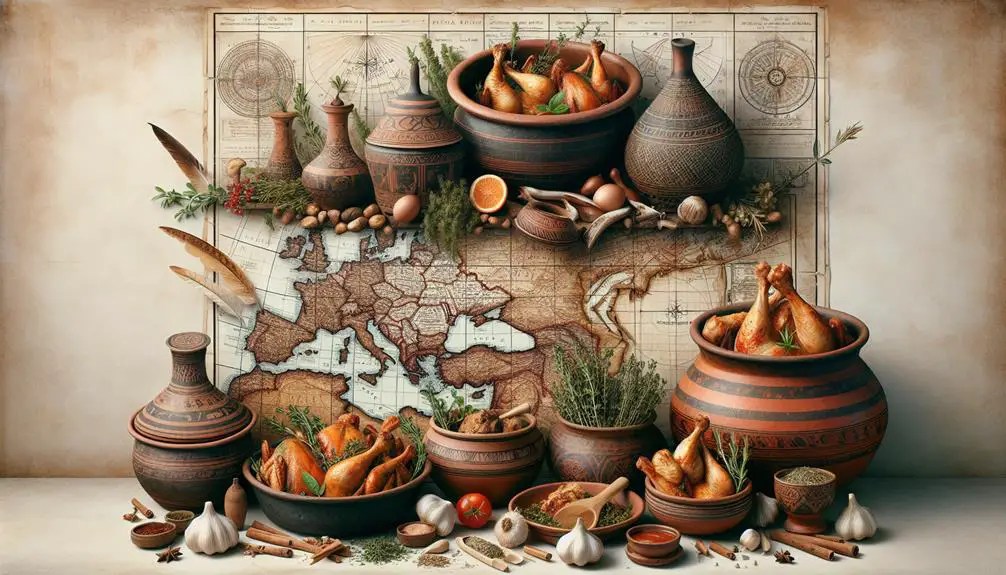
Mediterranean food is diverse because it has been influenced by many cultures over time. This includes the combination of local ingredients and cooking methods from the Mediterranean area.
This type of food tells a story of people moving, trading, and conquering, which has affected its flavors.
The Greeks and Romans were some of the first to shape this cuisine, focusing on grains, grapes, and olives.
These are still important in Mediterranean food today. Later, the Arabs brought new spices like saffron and nutmeg, and introduced sugar cultivation.
The Moors are credited with bringing rice to Spain, leading to dishes like paella.
When explorers discovered the Americas, they brought back tomatoes, which changed dishes in Italy and Greece, like pasta with tomato sauce and Greek salads.
Potatoes and peppers were also introduced to Spain, adding more variety.
With each new influence, the way of cooking in the Mediterranean also changed, mixing with existing methods.
This includes slow-cooked stews from North Africa, spice blends from the Middle East, and European baking and grilling. These have all shaped what we now know as Mediterranean cuisine.
In short, when you eat a dish like Chicken Jerusalem, you’re enjoying flavors that come from a long history of different cultures mixing together in the Mediterranean region.
Israeli Culinary Landscape

Israel’s food scene is a mix of Middle Eastern and European flavors, showing its diverse history. It’s not just about food but also the history of people moving, trading, and sharing cultures that created this unique food style.
In Israel, you can find dishes that mix flavors from places like India and Persia with the fresh approach of European settlers from the 20th century.
There are olives and citrus fruits from the region combined with the heavy breads and pastries from Eastern Europe.
Spices from the Levant mix with Mediterranean herbs, making a rich and harmonious mix of tastes.
People from the Jewish diaspora from all over the world have brought different flavors that have been mixed into the local food, making it a mix of many tastes.
You can find Moroccan tagines with deep flavors and Ashkenazi soups with subtle tastes, showing Israel’s complex culture.
In Israel, there’s a lot of new food being made. Chefs and home cooks mix traditional Middle Eastern ingredients with European cooking ways, making a wide variety of dishes.
From simple falafel stands on the street to fancy restaurants with new takes on classic dishes, Israel’s food scene shows how mixing different food styles can create something powerful.
Jerusalem as a Culinary Hub
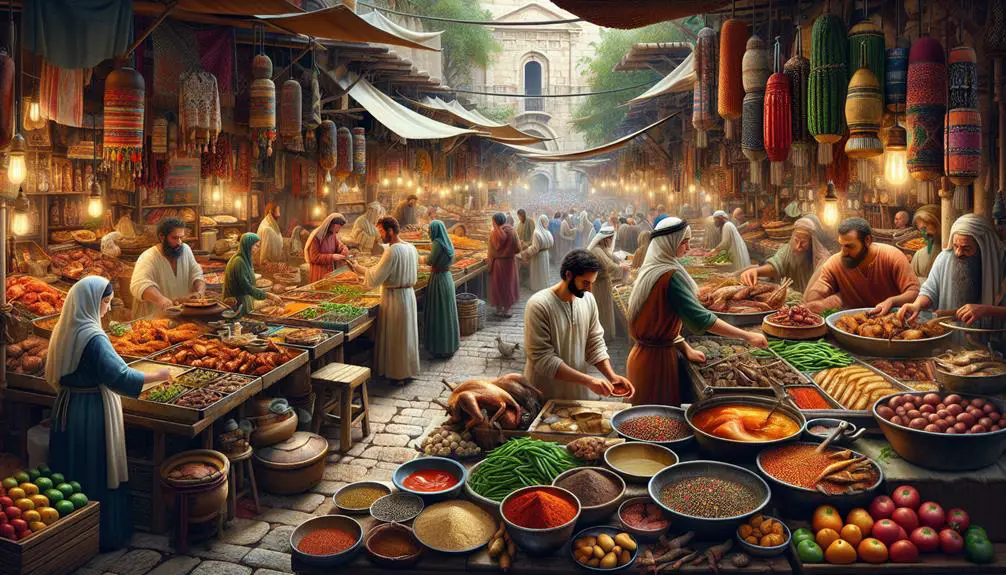
Jerusalem is a city with a long history and is now known for its food. It combines old cooking styles with new ideas to have a big effect on the food in the area.
The city is at the meeting point of different cultures, which has created a mix of flavors unique to Jerusalem.
As you explore the city, you see how the food from Jewish, Muslim, and Christian communities comes together, making a unique blend of tastes.
Middle Eastern spices mix with Mediterranean freshness.
There are traditional recipes that have been around for generations and new, innovative dishes.
Jerusalem’s food traditions have changed dishes in the area. For example, hummus in Jerusalem can include different ingredients like mushrooms or pomegranate.
Another dish, the Jerusalem mixed grill, shows the city’s mix of cultures with its variety of meats, spices, and sides.
Eating in Jerusalem is more than just eating; it’s about experiencing a culture that has developed over hundreds of years.
This culture keeps changing as new people come to the city, making Jerusalem’s food exciting and diverse.
Emergence of Chicken Jerusalem
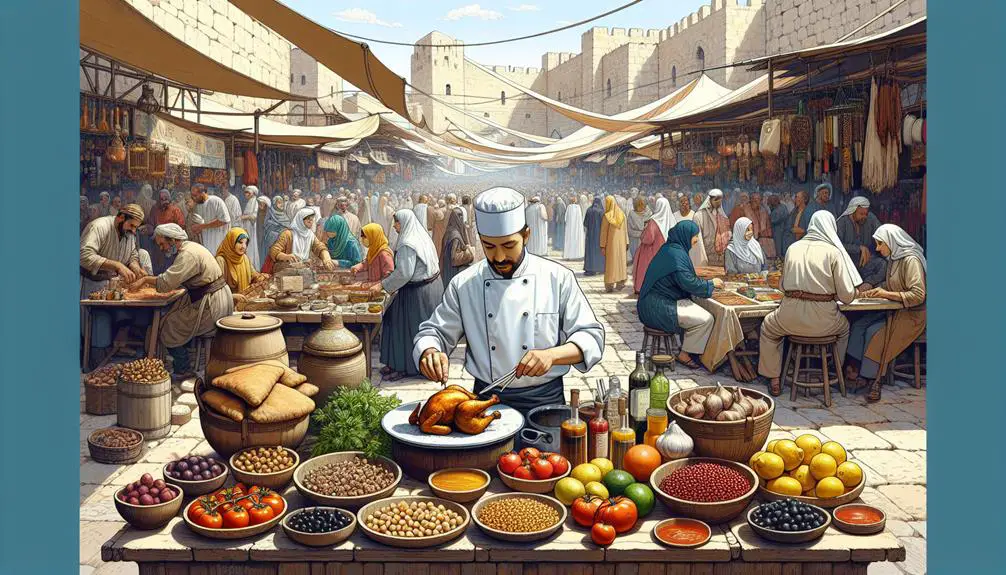
Chicken Jerusalem is a dish that shows Israel’s mix of cultures and tastes. This dish is more than just food; it’s a combination of many years of history, people moving from place to place, and different ways of cooking coming together.
The dish doesn’t come from one person or time. Many groups that have lived in Israel helped create it.
Jewish people coming back from around the world brought different cooking styles and ingredients.
Sephardic Jews added spices from the Iberian Peninsula, and Ashkenazi Jews brought flavors from Eastern Europe. These influences helped make Chicken Jerusalem.
Recently, chefs and food historians in Israel have helped make this dish more popular worldwide.
They’ve tried new ingredients and ways of cooking but kept the dish’s original spirit – celebrating Israel’s many cultures.
Eating Chicken Jerusalem is like going on a journey through time and across different places. It shows how Israel combines old and new to make something special.
Key Ingredients and Flavor Profiles
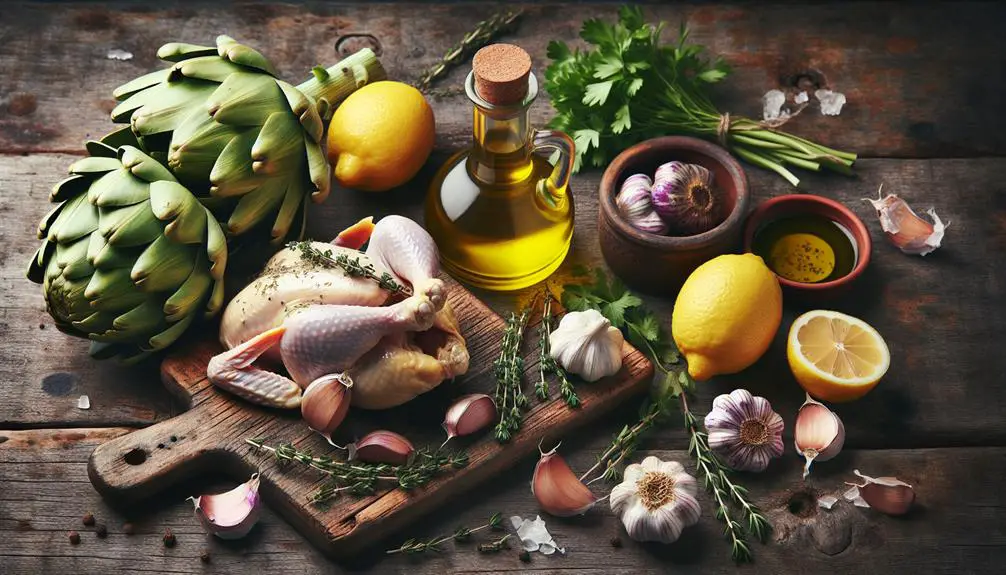
Exploring Chicken Jerusalem reveals its unique ingredients and flavors. Start with tender chicken cuts like breast or thigh for best results.
Marinate the chicken in local herbs and spices like garlic, thyme, and rosemary to add flavor.
Cooking the chicken slowly is important. This method makes the chicken tender and allows it to absorb the flavors fully.
Chicken Jerusalem is also known for using local ingredients like artichokes and olives. These ingredients add unique textures and tastes and reflect Jerusalem’s agricultural background.
Culinary Techniques
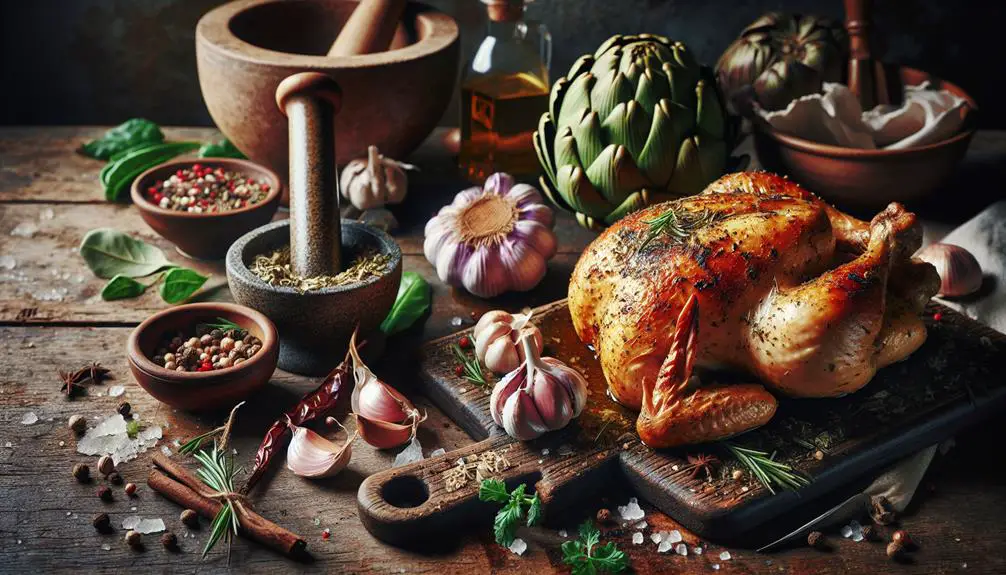
To make Chicken Jerusalem taste its best, it’s important to know how to roast or stew it properly and how to use marinades and spice blends to add flavor.
Roasting makes the chicken’s outside crispy and keeps the inside juicy. Make sure to preheat your oven and let the chicken come to room temperature before cooking it for even results.
Stewing cooks the chicken slowly in liquid, making the meat very tender and blending the flavors well.
Marinades are key for adding flavor and making the chicken tender. It’s best to marinate the chicken for a few hours or even overnight to let the flavors soak in.
The spices used in Chicken Jerusalem, like sumac, za’atar, and cumin, add unique tastes such as earthy, citrusy, and warm flavors.
Mixing these spices with olive oil, garlic, and lemon juice in your marinade will make the chicken taste much better.
Cultural Significance
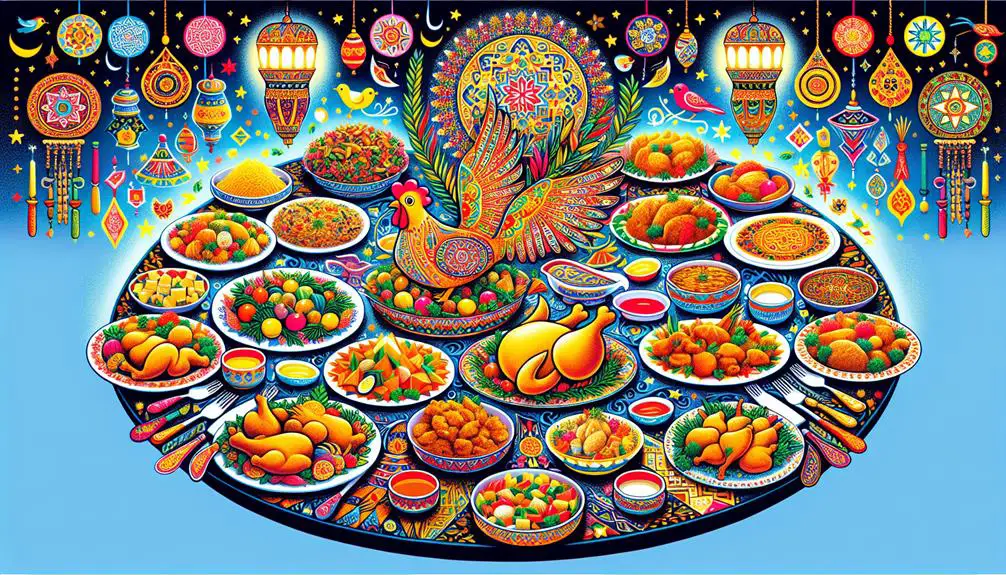
Learning how to properly roast or stew Chicken Jerusalem and improve its taste with different marinades and spices is important for understanding its cultural importance.
Chicken Jerusalem isn’t just a dish; it’s a way to celebrate culture and traditions, and it varies a lot from one place to another.
In some cultures, Chicken Jerusalem is a symbol of wealth and togetherness. During big festivals, families come together to eat this carefully made dish, share stories, and make new memories.
The way the chicken is marinated and cooked can show where a family comes from and the specific area they’re from.
Each ingredient added has its own history and tells a story about ancestors and how they moved around, affecting the area’s food.
For instance, near the Mediterranean, Chicken Jerusalem might be made with citrus and herbs, showing off the local food and tastes.
In areas with a history of spice trade, the dish might’ve spices like turmeric and cumin, giving a stronger flavor and connecting to the history of trade in that place.
On special days, making Chicken Jerusalem is something everyone can help with, from the youngest who cleans the vegetables to the oldest who knows the best way to marinate.
This doesn’t just make the dish tastier but also helps bring family members closer, making Chicken Jerusalem a symbol of culture and togetherness.
Evolution of Chicken Jerusalem

Over time, the recipe for Chicken Jerusalem has changed. It started as a simple dish with chicken, artichokes, herbs, and sometimes cream or white wine.
Now, it includes new ingredients and is presented in different ways, showing the creativity of Israeli cuisine.
Originally, Chicken Jerusalem was a basic dish that was comforting and used local ingredients.
Now, chefs in Israel are adding new flavors to it like pomegranate molasses, sumac, and tahini. These changes make the dish more flavorful and show the diverse cultures in Israel.
Also, how Chicken Jerusalem is served has changed. It’s not just a main dish anymore. It can be part of a salad, inside pastries, or turned into soup.
The look of the dish is also important now, with a focus on making it look as good as it tastes.
This shows how Chicken Jerusalem isn’t just a meal, but a story about culture, creativity, and community that keeps changing with time.
Notable Recipes

Let’s explore some popular Chicken Jerusalem recipes, including ingredients, measurements, and instructions. These recipes are famous in Israeli kitchens.
First, we’ll make a traditional Chicken Jerusalem. You need 4 boneless chicken breasts, 2 cups of artichoke hearts, 1 cup of heavy cream, ½ cup of chicken broth, 2 minced garlic cloves, and some herbs.
Season the chicken with salt and pepper, then fry it in olive oil over medium heat.
After taking out the chicken, add garlic, artichokes, broth, and cream to the pan. Simmer it, put the chicken back, and cook until ready. Serve with rice or pasta.
Next, try a version with pomegranate and walnuts. Use the same basic ingredients but add ½ cup of pomegranate seeds and ¼ cup of crushed walnuts to the sauce.
The pomegranate adds a tangy taste, and the walnuts give a crunchy texture.
Chefs have also made gourmet versions, adding spices like za’atar and sumac for a Middle Eastern touch. Some use coconut milk instead of heavy cream to make it dairy-free.
Each version of Chicken Jerusalem shows how flexible this dish is, fitting both traditional and modern tastes in Israeli food.
Whether you follow the classic recipe or try something new, you’ll enjoy a tasty meal.
Global Recognition and Influence

Chicken Jerusalem has become popular all over the world because it can be easily adapted to fit different culinary styles.
In Paris, fancy restaurants add a French touch to it, while in Bangkok, it’s found as street food with spicy Thai flavors. Chefs enjoy mixing it with local tastes and ingredients, creating new and exciting versions.
Around the world, you’ll find Chicken Jerusalem in many unexpected places, each version showing how cultures can mix through food. In Italy, it’s often served with creamy risotto, where the taste of Jerusalem artichokes adds to the dish’s richness.
In Mexico, some creative cooks serve it in tortillas with guacamole, adding a Middle Eastern flavor to a traditional taco.
The popularity of Chicken Jerusalem isn’t just in restaurants.
Many people cook it at home and share their unique versions online, trying out vegan options or different cooking methods like sous vide. This shows how much people like the dish and are willing to experiment with it.
Chicken Jerusalem is a great example of how food can cross cultural boundaries and bring people together.
Whether you’re an experienced chef or just starting to cook, this dish is something everyone can enjoy and appreciate.
Wrapping up
Chicken Jerusalem has an interesting story. It started in areas around the Mediterranean Sea and is now known all over the world. This dish is special because it mixes different tastes in a unique way.
It has changed over time, taking bits from old recipes and adding new ideas. People love it for its flavors, its history, and how famous it has become.
Now, you can try making Chicken Jerusalem at home and be part of its ongoing story.
